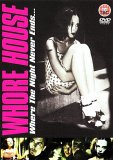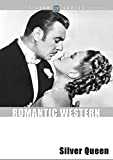![A Personal Journey With Martin Scorsese Through American Movies [1995]](/pictures/1032838.jpg) A Personal Journey With Martin Scorsese Through American Movies | DVD | (05/06/2000)
from £17.13
| Saving you £4.62 (30.06%)
| RRP
A Personal Journey With Martin Scorsese Through American Movies | DVD | (05/06/2000)
from £17.13
| Saving you £4.62 (30.06%)
| RRP Scorsese's invigorating history of American movies avoids the straitjacket of chronology. Although he makes dutiful nods in the direction of Edwin S. Porter, D.W. Griffith and Orson Welles, he is equally interested in figures working at the margins, film-makers such as Andre De Toth, Ida Lupino, Sam Fuller and Edgar Ulmer, "who circumvented the system to get their vision onto the screen". He describes them as "illusionists", "smugglers", con artists who managed to hoodwink the money men into allowing them to make the films they wanted. Some worked in B-movies ("less money, more freedom") others (like Scorsese himself) struck their own Faustian bargains with the studios, making "one movie for them, one for yourself"His heroes are the outsiders, the film-makers who chafe against the assurances of the American dream. He offers a vivid, guilty vignette of himself as a four-year-old child, sitting in a darkened auditorium watching in amazement as Gregory Peck overpowers Jennifer Jones in Duel in the Sun, one of the first films his mother took him to. "The savage intensity of the music, the burning sun, the overt sexuality ... it seems that the two could only consummate their passion by killing each other". There's a certain irony in Scorsese, who once seriously considered becoming a priest, succumbing to a David O. Selznick Technicolor extravaganza which had already been condemned by the church.While often sounding like a serious-minded apprentice who watches old movies to pick up tips which will help him in his own work ("study the old masters, enrich your palette, expand the canvas-there's always so much more to learn") he never overlooks the illicit pleasure that cinema can bring. "I don't really see a conflict between the church and the movies, the sacred and the profane". --Geoffrey Macnab
![Anatomy of a Murder (Criterion Collection) [Blu-ray] [2019] [Region Free]](/pictures/1150973.jpg) Anatomy of a Murder (Criterion Collection) | Blu Ray | (16/03/2020)
from £12.75
| Saving you £N/A (N/A%)
| RRP
Anatomy of a Murder (Criterion Collection) | Blu Ray | (16/03/2020)
from £12.75
| Saving you £N/A (N/A%)
| RRP A virtuoso JAMES STEWART (Vertigo) plays a small-town Michigan lawyer who takes on a difficult case: that of a young Army lieutenant (The Killing of a Chinese Bookie's BEN GAZZARA) accused of murdering the local tavern owner who he believes raped his wife (Days of Wine and Roses' LEE REMICK). This gripping, envelope-pushing courtroom potboiler, the most popular film from Hollywood provocateur OTTO PREMINGER (Laura), was groundbreaking for the frankness of its discussion of sexmore than anything else, it is a striking depiction of the power of words. With its outstanding supporting cast including a young GEORGE C. SCOTT (Patton) as a fiery prosecuting attorney and legendary real-life attorney JOSEPH N. WELCH as the judgeand influential jazz score by DUKE ELLINGTON, Anatomy of a Murder is a Hollywood landmark; it was nominated for seven Oscars, including best picture. Special Edition Features New high-definition digital restoration, with uncompressed monaural soundtrack on the Blu-ray edition New alternate 5.1 soundtrack, presented in DTS-HD Master Audio on the Blu-ray edition New interview with Otto Preminger biographer Foster Hirsch Critic Gary Giddins explores Duke Ellington's score in a new interview A look at the relationship between graphic designer Saul Bass and Preminger with Bass biographer Pat Kirkham Newsreel footage from the set Excerpts from a 1967 episode of Firing Line, featuring Preminger in discussion with William F. Buckley Jr. Excerpts from the work Anatomy of Anatomy: The Making of a Movie Behind-the-scenes photographs by Life magazine's Gjon Mili Trailer, featuring on-set footage PLUS: A booklet featuring an essay by critic Nick Pinkerton and a 1959 Life magazine article on real-life lawyer Joseph N. Welch, who plays the judge in the film
![Eye Of The Needle [1981]](/pictures/1020394.jpg) Eye Of The Needle | DVD | (08/01/2001)
from £N/A
| Saving you £N/A (N/A%)
| RRP
Eye Of The Needle | DVD | (08/01/2001)
from £N/A
| Saving you £N/A (N/A%)
| RRP Donald Sutherland and Kate Nelligan ignite the screen as ill-fated lovers in the exciting emotionally involving thriller. Based on the best-selling novel by Ken Follet this searing mystery is a roller coaster ride of suspense centering on the relationship between master spy and a brave woman - with the fate of the world hanging in the balance. Englishmen know him as Faber but to the fatherland he's the loyal and lethal spy known as 'The Needle.' On his way back to Germany Fabe
![The Lost World [1925]](/pictures/1012371.jpg) The Lost World | DVD | (11/08/2003)
from £12.98
| Saving you £-7.99 (N/A%)
| RRP
The Lost World | DVD | (11/08/2003)
from £12.98
| Saving you £-7.99 (N/A%)
| RRP The granddaddy of giant monster movies, The Lost World was one of the most expensive movies ever made in 1925, costing more than a million dollars, and has remained one of the most influential. Every larger-than-life creature feature since--from King Kong to Godzilla and Jurassic Park--owes a debt to this original adventure fantasy based on Arthur Conan Doyle's novel. It's the story of a maverick scientist (Wallace Beery under a bushy beard) who finds a land that time forgot on a plateau deep within the South American jungles and comes back to London with a captured brontosaurus to prove it. His expedition includes Bessie Love, the daughter of an explorer who disappeared on the previous expedition, and big game hunter Lewis Stone. The ostensible stars of the picture are all upstaged by Willis O'Brien's dinosaurs, simple models brought to life with primitive stop-motion animation (the technique was soon to be perfected by O'Brien for King Kong). Hardly realistic by any measure, these pioneering special effects are still a sight to behold, especially the lumbering brontosaurus which receives the most care from O'Brien, both foraging in his jungle and rampaging through the streets of London. With the coming of talkies, The Lost World became obsolete: all known American prints were destroyed in favour of a sound remake (which became King Kong) and the film only survived in a severely truncated form (even the original negative was lost). For this release David Shepard meticulously "rebuilt" the film using material from eight different surviving prints from all over the world, cleaning and restoring along the way. The result is 50% longer than previously extant prints, still not complete but closer than any version since its 1925 debut. The difference is not merely in restored scenes but in a rediscovered sense of grace in scenes filled out to their original detail and pace. The film moves and breathes once again like a silent film. On the DVD: From the attractive solid slipcase to the wonderful "period" menu interface, this is a delightful DVD package. The film itself looks surprisingly good--a real tribute to the restoration team's efforts--with careful tinting in the style of the period (blues for evening, reds for dawn etc.). The disc features the choice of either an original score by The Alloy Orchestra or a classical orchestral score compiled and conducted by Robert Israel (both enjoyable and effective), 13 minutes of O'Brien's animation outtakes (including a couple of isolated frames that capture O'Brien manipulating his models) and a well-meaning but basic commentary by Arthur Conan Doyle historian Roy Pilot. There's also a text biography of Conan Doyle and a display of original postcards, posters and other promotional items. --Sean Axmaker, Amazon.com
![American in Paris [Blu-ray] [2009] [US Import]](/pictures/1153344.jpg) American in Paris | Blu Ray | (31/03/2009)
from £N/A
| Saving you £N/A (N/A%)
| RRP
American in Paris | Blu Ray | (31/03/2009)
from £N/A
| Saving you £N/A (N/A%)
| RRP ![Citizen Kane [1941]](/pictures/1039179.jpg) Citizen Kane | DVD | (29/05/2006)
from £12.26
| Saving you £7.73 (63.05%)
| RRP
Citizen Kane | DVD | (29/05/2006)
from £12.26
| Saving you £7.73 (63.05%)
| RRP In May of 1941 RKO Radio Pictures released a controversial film by a 25-year-old first-time director. That premier of Orson Welles' Citizen Kane was to have a profound and lasting effect of the art of motion pictures. It has been hailed as the best American film ever made and it's as powerful a film today as it was fifty years ago. It earned eight Academy Award nominations and won the Oscar for Best Screenplay. Through its unique jigsaw-puzzle storyline inventive cinemato
![John Wayne - 3 On 1 - Star Packer / Arizona Skies / Lawless Frontier [1935]](/pictures/1003578.jpg) John Wayne - 3 On 1 - Star Packer / Arizona Skies / Lawless Frontier | DVD | (21/01/2002)
from £8.50
| Saving you £-2.51 (N/A%)
| RRP
John Wayne - 3 On 1 - Star Packer / Arizona Skies / Lawless Frontier | DVD | (21/01/2002)
from £8.50
| Saving you £-2.51 (N/A%)
| RRP John Wayne - The Restored Collection' brings The Duke's classic early westerns to DVD as they have never been seen before. Using the original negatives held in the vaults of Republic Studios the films have been remastered to a standard of the highest possible quality. A man who leads a crowd of trouble makers is made sheriff in 'The Star Packer'. In 'Neath The Arizona Skies' a cowboy protects an indian princess from outlaws. 'In Lawless Frontier' a man must prove his innocence.
![The Lawless Frontier [1935]](/pictures/1001638.jpg) The Lawless Frontier | DVD | (23/02/2004)
from £6.36
| Saving you £6.63 (104.25%)
| RRP
The Lawless Frontier | DVD | (23/02/2004)
from £6.36
| Saving you £6.63 (104.25%)
| RRP John Wayne plays a wrongly accused cowboy who must prove his innocence by taking on the real criminals...
![The Lawless Frontier [1935]](/pictures/1012360.jpg) The Lawless Frontier | DVD | (11/08/2003)
from £N/A
| Saving you £N/A (N/A%)
| RRP
The Lawless Frontier | DVD | (11/08/2003)
from £N/A
| Saving you £N/A (N/A%)
| RRP John Wayne plays a wrongly accused cowboy who must prove his innocence by taking on the real criminals...
![Hollywood Without Make Up [DVD]](/pictures/1111471.jpg) Hollywood Without Make Up | DVD | (17/10/2011)
from £10.98
| Saving you £2.01 (15.50%)
| RRP
Hollywood Without Make Up | DVD | (17/10/2011)
from £10.98
| Saving you £2.01 (15.50%)
| RRP Written by Royal Foster, this program features rare candid footage of Hollywood's royalty, filmed by actor Ken Murray. Over the decades, Murray built an unparalleled collection of home movies of Hollywood's rich and famous. Highlights of this compilation include the television debuts of Marilyn Monroe and Kirk Douglas, and documentary footage of the filming of Gunga Din (1939). Other stars seen in unguarded, relaxed, or playful moments include Clark Gable, Cary Grant, Marilyn Monroe, Dick Powell, Mae West, Humphrey Bogart, Laurel and Hardy, Jane Mansfield, the Marx Brothers, John Wayne, Robert Taylor and Walt Disney
 Whore House | DVD | (13/11/2006)
from £21.58
| Saving you £-5.59 (N/A%)
| RRP
Whore House | DVD | (13/11/2006)
from £21.58
| Saving you £-5.59 (N/A%)
| RRP Cosmo, a pimp running a whorehouse in LA, is in trouble with the local Russian mob. When his seductive niece suddenly shows up looking for her missing father, Cosmo's life starts spiraling out of control.
 Silver Queen (ClassicFlix Silver Series) | DVD | (28/09/2021)
from £N/A
| Saving you £N/A (N/A%)
| RRP
Silver Queen (ClassicFlix Silver Series) | DVD | (28/09/2021)
from £N/A
| Saving you £N/A (N/A%)
| RRP 
Please wait. Loading...
This site uses cookies.
More details in our privacy policy